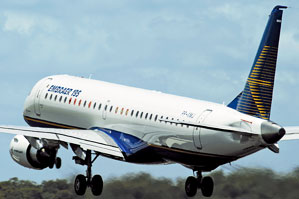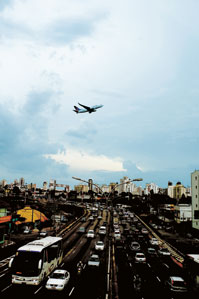
embraerThe wings and landing gear mainly account for aircraft noiseembraer
Global air traffic has been growing non-stop for the last several decades and is expected to maintain this trend going forward. Estimates produced by Iata, the International Air Transport Association, indicate that passenger movement will reach 2.75 billion trips in 2011, vs. 2.13 billion in early 2007. One of the challenges that the aeronautical industry faces in order to continue evolving without worsening the quality of life in cities is to design and develop quieter aircraft that can be used in airports without bothering those who live nearby. A new requirement of the FAA – Federal Aviation Administration (the agency that regulates the air sector in the United States), which is to go into effect as of 2015, will further restrict aircraft noise in airports.
To adapt to this and maintain its global competitiveness, Embraer, the world’s third largest aircraft manufacturer, recently embarked upon a broad project called Silent Aircraft: a study of aero-acoustics, designed to identify and evaluate the noise that Embraer planes generate and propagate. Based on its results, the firm plans to implement engineering solutions to make its aircraft even quieter. “In large cities, airplane noise only loses to car noise,” states engineer Micael Gianini Valle do Carmo, who is responsible for this project at Embraer. “The initiative of studying the external noise produced by our aircraft arose a few years ago as part of the project of the Embraer 170/190 family of jets, which were far larger planes than those we had manufactured previously.” The program, which benefits from FAPESP financial aid through the Pite program (Research Partnership for Technological Innovation), focuses on the so-called airframe noise (or aerodynamic noise), generated by the air flowing around the aircraft’s wings and fuselage. Together, FAPESP and Embraer have earmarked R$ 11 million for this program, which will take three years.
In the last few years, technological progress has transformed aircraft engines into quieter equipment, as a result of which aerodynamic noise now stands out. During landing, some 75 to 80 percent of the aircraft’s noise is of aerodynamic origin, the rest being produced by the engine. During takeoff, when the aircraft needs more power in order to rise into the air, this ratio is the opposite. “The main sources of aerodynamic noise during takeoff and landing are the landing gear and the hyper-supporting surfaces, in other words, the set of wings and of flaps and slats, the latter being the mobile devices on the wings whose purpose is to expand the surface area in order to increase aircraft lift. The noise comes from air vortex effects and pressure fluctuation at these points,” explains engineer Julio Romano Meneghini, a professor at the Politécnica School of Engineering of the University of São Paulo (Poli/USP) and the project’s general coordinator.
Besides Poli/USP, the program also involves another five Brazilian teaching and research centers, and four foreign ones: the São Carlos School of Engineering of the University of São Paulo, the Federal University of Santa Catarina (UFSC), the University of Brasilia (UnB), the Aeronautics Technical Institute (ITA), the Federal University of Uberlandia (UFU), Twente University in the Netherlands, Imperial College and the University of Southampton, both in England, and the Germanic Aerospace Center (DLR in German) in Germany. The researchers plan to attack the issue with three different but complementary aero-acoustics approaches: flight and wind tunnel trials, analytical and empirical models, and computational aero-acoustics. The latter will be centered in the Poli/USP Fluid Dynamics Center, which will get a supercomputer with more than 1,200 core processing units (CPUs) and 2.5 terabytes of memory, acquired with the project’s funds. “We’ll model and numerically simulate the air flow around the hyper-lift surfaces and the landing gear. By simulating the airflow we will get to the structure of the vortices that are formed and thus we’ll have an estimate of the noise generated over these surfaces,” states Meneghini. “With the help of the supercomputer, one of the most advanced in Brazil, we’ll learn about the complex phenomenon of aerodynamic noise generation concretely and then we’ll be able to suggest to Embraer changes in the geometry of these elements, such as a wings, flaps, landing gear and others,” he says.
The experimental part of the program will be carried out at the testing runway of the Embraer unit in the town of Gavião Peixoto, in inner-state São Paulo. Its objective will be to identify the sources of aerodynamic noise and to quantify them. To raise this information, 256 microphones will be installed in an area of 50 meters by 50 meters at the start of the runway, in order to record aircraft noise during countless take-offs and landings. The reason for so many microphones is that aircraft noise is very complex. “Based on the processing of acoustical data, we will learn the percentage of noise caused by flaps, landing gear, slats and so on,” highlights Meneghini. According to him, the results of these trials will enable the researchers, among other things, to develop aerodynamic noise reduction kits to be applied to specific points of the aircraft. This part of the work will be the responsibility of UFSC and of the São Carlos School of Engineering. “We’ll be in charge of developing experimental tools and of diagnosing the sources of aircraft noise,” says professor César José Deschamps, from the UFSC Mechanical Engineering Department. “We’ll also carry out studies to understand aeronautical noise from a more theoretical point of view and, once we reach this understanding, to use better methods to foresee it. This way we’ll be able to propose changes in Embraer’s aircraft designs,” states Deschamps.
 Miguel BoyayanAnother branch of this project, for which the University of Brasilia (UnB) is resposible, is the study of the noise generated by the engine fan. The fan, a type of propeller with a large number of blades, is the second greatest source of noise in aircraft propulsion systems, only outdone by the jet of hot air that the engines push out. Though it does not manufacture its engines, supplied by US manufacturer General Electric, Embraer wants to study this kind of noise because it manufactures the nacelle, the metal structure in which the turbofan engine is mounted. “The nacelle is the first line of combat regarding engine noise,” explains professor Roberto Bobenrieth Miserda, from the UnB Technology Institute.
Miguel BoyayanAnother branch of this project, for which the University of Brasilia (UnB) is resposible, is the study of the noise generated by the engine fan. The fan, a type of propeller with a large number of blades, is the second greatest source of noise in aircraft propulsion systems, only outdone by the jet of hot air that the engines push out. Though it does not manufacture its engines, supplied by US manufacturer General Electric, Embraer wants to study this kind of noise because it manufactures the nacelle, the metal structure in which the turbofan engine is mounted. “The nacelle is the first line of combat regarding engine noise,” explains professor Roberto Bobenrieth Miserda, from the UnB Technology Institute.
According to Julio Meneghini, the foreign institutions involved in the program will play an important role. Twente University, in the Netherlands, will make available a wind tunnel for aero-acoustical trials, whereas the University of Southampton and Imperial College in England offer their experience in the field of simulators and simplified analytical models. “They have experience of long standing in this field and they will use these empirical models to make noise estimates,” says Meneghini. There are also plans for an interchange of Brazilian, Dutch and English students from the participating institutions.
The silent aircraft project, in addition to theoretical progress, to the development of methodologies and to the creation of tools with which to understand the phenomena involved in the issue of aircraft noise will also serve to train human resources specialized in this field, because there are only a few aero-acoustics experts in Brazil. Therefore, part of the program’s funds will be used to finance grants for undergraduate research, master’s degrees, PhDs and post-graduate work for students doing research into the program’s themes. “We want to create a center of competence in the acoustics field and to put highly qualified experts at the disposal of the domestic aeronautical industry,” highlights engineer Deschamps, from UFSC. At present, part of the study and evaluation of the levels of Embraer aircraft’s external noise is carried out by international external consultants, which creates certain difficulties, such as slow responses to critical situations. Besides a team comprised of some 25 researchers from Embraer and universities, it is estimated that approximately 40 students will also take part in the project.
Programs similar to this one financed by FAPESP and Embraer are also being carried out in firms and research institutions for the American and European aerospace industry. Nasa, the US space agency, leads the project Quiet Aircraft Technology (QAT), which aims at cutting aircraft noise by half within ten years and by 75% within the next 25 years. It is estimated that the first aircraft that will incorporate some of the advances provided by QAT technology will start being produced in 2010. Another American program, Advanced Subsonic Technology, in which Nasa is also involved, along with the federal government and private initiative, aims at producing devices for reducing noise by 20 decibels relative to the technology that existed in 1997, by 2020. This is a bold target; if met, it will represent, for instance, a reduction of some about 20% in the noise of a Boeing 777 during landing, when it generates about 100 decibels. The European Community, in turn, is sponsoring the Silence(R) theme project, involving 51 enterprises from 14 countries and a budget of 110 million euros. Its objective is to validate noise reduction technology with a view to cutting aircraft operation noise by as much as six decibels.
Forced retirement
English jet retired due to engine noise
One of the most successful British aircraft ever, the BAC 1-11 (One Eleven) had to be retired due its engine noise. Designed by Hunting Aircraft and produced by British Aircraft Corporation (BAC), it was launched in the early 1960’s and flew for roughly 30 years, until it was retired as a result of noise restrictions. Other airplanes, such as the Boeing 737-200, the Douglas DC-8 and the Tupolev Tu-154 might have met the same fate were it not for the invention of an anti-noise device called the hush kit, created to reduce the noise of the old turbofan engines of the low-bypass kind; the current high-bypass models are far quieter. The hush-kit is a sort of exhaust system placed at the end of the turbine that muffles the noise in old planes. Another benefit of this technology is that it cuts down on the engine’s emissions of polluting gases.
The Project
Quiet aircraft: an aeroacoustic investigation (nº 06/52568-7); Type Pite (Research Partnership for Technological Innovation); Coordinator Julio Romano Meneghini – USP; Investment R$ 707,506.58, US$ 1,709,305.41 (FAPESP) and R$ 6,000,000.00